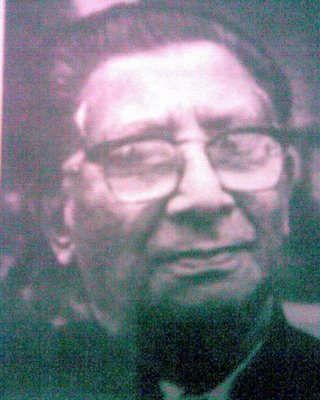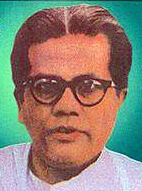Introduction to Syed Abdul Malik
Syed Abdul Malik was a celebrated figure in Assamese literature, known for his profound storytelling and impactful narratives. Born on January 15, 1919, in Naharani Village of Golaghat district, Assam, he dedicated his life to enriching Assamese literature. His father, Syed Rahmat Ali, and mother, Syeda Lutfun Nissa, played an essential role in shaping his early life. From a young age, he displayed an exceptional talent for writing, leading to a literary journey that spanned over five decades.
The Beginning of a Prolific Career
Syed Abdul Malik’s literary journey began early, with his first novel, La Sa Gu, published in the renowned Assamese monthly magazine Banhi during 1945-46. Inspired by literary giants like Anton Chekhov and Guy de Maupassant, he developed a unique storytelling style that combined realism with deep emotional insight. His ability to portray the complexities of human nature set him apart from his contemporaries.
A Versatile Storyteller with a Rich Literary Legacy
Malik’s writing was incredibly diverse, covering various genres, including short stories, novels, poetry, plays, and travelogues. Some of his most well-known literary works include:
- Parasmani
- Ajani Natun Suwali
- Rangagara
- Moraha Papari
His vast contribution to Assamese literature remains unparalleled. With over 60 novels, 11 plays, five poetry collections, five children’s books, three travelogues, and nearly 1000 short stories, his literary impact is unmatched.
Themes in His Writing
Syed Abdul Malik’s stories often revolved around two central themes—romantic narratives and socially conscious tales. His ability to weave together diverse characters and experiences gave his stories an unparalleled richness. He explored various aspects of Assamese society, shedding light on economic hardships, social injustices, and emotional struggles.
Unique Writing Style and Influences
One of the defining aspects of Malik’s storytelling was his technical brilliance. He was known for his mastery of suspense, character depth, and detailed societal observation. He introduced the “Chekhovian atmosphere” to Assamese literature, making his stories engaging and thought-provoking.
Some of his remarkable short stories include:
- Pran Haruar Pisat – A gripping narrative with a suspenseful twist.
- Barakharar Barasun – A story depicting economic distress and self-respect.
- Bibhatsa Bedana – A controversial yet socially conscious story dealing with deep psychological themes.
His works weren’t just about entertainment; they reflected the raw emotions and struggles of ordinary people, making them deeply relatable to readers.
A Voice for Social Change
Malik didn’t just write stories; he used his words as a tool for social reform. His short story Anneswan (Search) presents the life of a prostitute, not as an untouchable outcast, but as a human being with emotions and dignity. Another unique piece, Dookhan Bhari (Two Legs), explores the hero’s conflicting emotions—his admiration for a young girl’s beauty and his strong patriotic feelings when he learns her father had opposed the freedom struggle.
Notable Novels and Their Impact
Malik’s novels brought fresh perspectives to Assamese literature. Some of his most famous works include:
- Adharxila (Foundation Stone)
- Doctor Arunabhor Asampurna Jivani (Dr Arunabh’s Unfinished Biography)
- Kavitar Naam Labha (Lava is the Name of the Poem)
- Aghari Atmar Kahini (Tale of Nomadic Souls)
- Pran Samudra (Ocean of Life)
- Trisul (Trident)
- Dukhan Nadi aru Ekhon Marubhumi (Two Rivers and a Desert)
- Rup Tirhar Yatri – Based on the life of Rupkonwar Jyoti Prasad Agarwalla.
- Dhanya Nara Tanu Bhaal – A novel highlighting the life and times of the great Vaishnavite saint Sankaradeva.
His extensive research work, Asamiya Zikir Aru Jari, was a monumental study on the life of the 17th-century Muslim saint Ajan Fakir, further showcasing his commitment to Assamese heritage.
Academic and Literary Contributions
Apart from being a literary genius, Malik also contributed immensely to academics. He served as a professor of Assamese language and literature for 40 years, mentoring students and inspiring future generations of writers. His involvement with various literary organizations, including the prestigious Asom Sahitya Sabha, helped shape Assamese literature. He was the president of the Sahitya Sabha session held in Abhayapuri in 1977 and even served as a Rajya Sabha member in 1983.
Awards and Recognitions
For his outstanding contributions to literature, Syed Abdul Malik received several prestigious awards:
- Sahitya Akademi Award for Aghari Atmar Kahini
- Padma Shri in 1984
- Padma Bhushan in 1992
- Srimanta Sankaradeva Award in 1999
These honors reflect the immense respect he earned for his work, not just in Assam but across India.
End of an Era: Syed Abdul Malik’s Legacy
On December 20, 2000, Syed Abdul Malik passed away at the age of 81, leaving behind a literary legacy that continues to inspire readers and writers alike. His work remains a bridge between pre- and post-World War literature in Assam, capturing the evolving socio-political landscape through powerful storytelling.
His ability to portray human emotions, social struggles, and cultural richness in Assamese Literature ensures that his works remain timeless. Readers today still find themselves captivated by the depth and authenticity of his stories. Syed Abdul Malik’s contribution to Assamese literature was not just vast in quantity but also unparalleled in quality, making him one of the most significant literary figures of all time.
FAQ’s:
Q 1. Who was Syed Abdul Malik?
Syed Abdul Malik was a renowned Assamese writer known for his contribution to literature through novels, short stories, plays, and poetry. His work covered a wide range of themes, from romance to social issues, making him one of the most influential writers in Assamese literature.
Q 2. Where was Syed Abdul Malik born?
He was born on January 15, 1919, in Naharani Village, located in the Golaghat district of Assam. His parents were Syed Rahmat Ali and Syeda Lutfun Nissa.
Q 3. What was his first novel?
His first novel, La Sa Gu, was published in the Assamese magazine Banhi between 1945 and 1946. It marked the beginning of his long and successful writing career.
Q 4. Which writers influenced Syed Abdul Malik’s works?
He was highly influenced by Anton Chekhov and Guy de Maupassant, adopting their storytelling techniques. His works often reflected Chekhovian themes, blending realism with deep human emotions.
Q 5. What kind of themes did he explore in his writings?
His stories were diverse, covering romance, social issues, economic struggles, and human psychology. He was known for highlighting societal problems and giving a voice to different sections of society through his characters.
Q 6. Which are some of his most famous short stories?
Some of his notable short stories include Anneswan (Search), which portrays a prostitute as a human being rather than an outcast, and Dookhan Bhari (Two Legs), which explores the clash between personal attraction and patriotism.
Q 7. How many books did Syed Abdul Malik write?
Throughout his literary career, he wrote 60 novels, 11 plays, five poetry collections, five children’s books, three travelogues, and around 1,000 short stories. His contribution to Assamese literature was unmatched.
Q 8. What are some of his most famous novels?
His popular novels include Adharxila, Doctor Arunabhor Asampurna Jivani, Kavitar Naam Labha, Aghari Atmar Kahini, Pran Samudra, Trisul, and Dukhan Nadi aru Ekhon Marubhumi.
Q 9. Did Syed Abdul Malik receive any awards?
Yes, he was honored with the Padma Shri in 1984 and the Padma Bhushan in 1992. He also received the Sahitya Akademi Award for his novel Aghari Atmar Kahini and the Srimanta Sankaradeva Award in 1999.
Q 10. When did Syed Abdul Malik pass away?
He passed away on December 20, 2000, at the age of 81. His legacy continues to inspire Assamese literature and culture.












